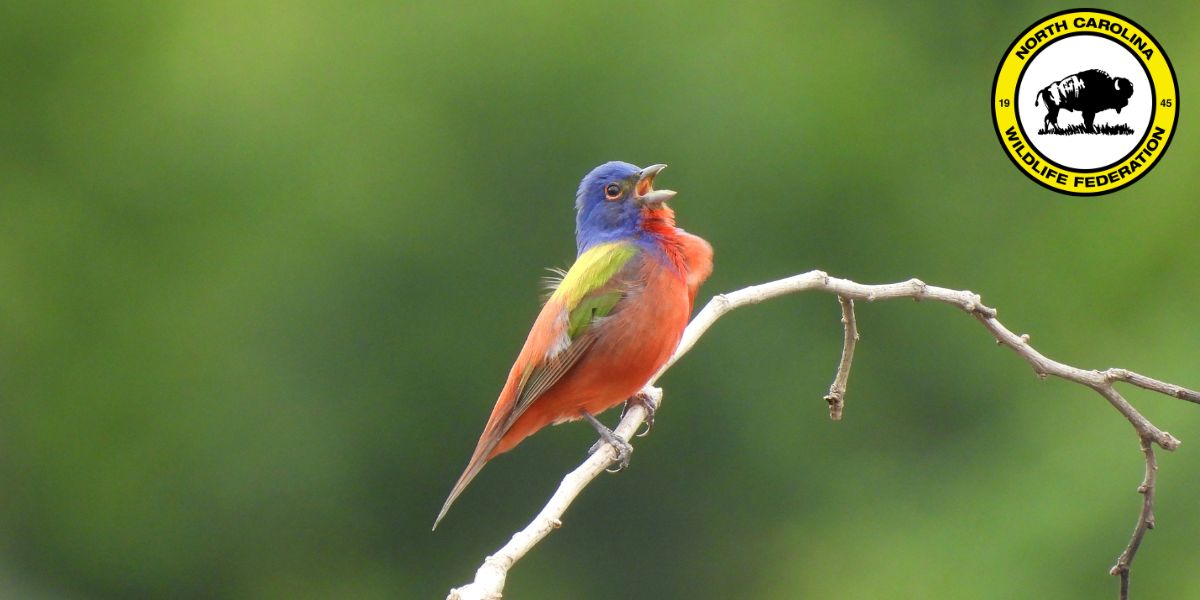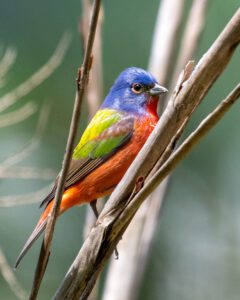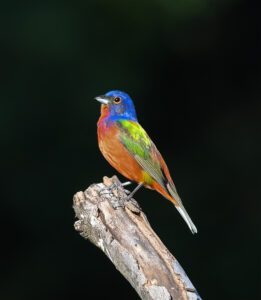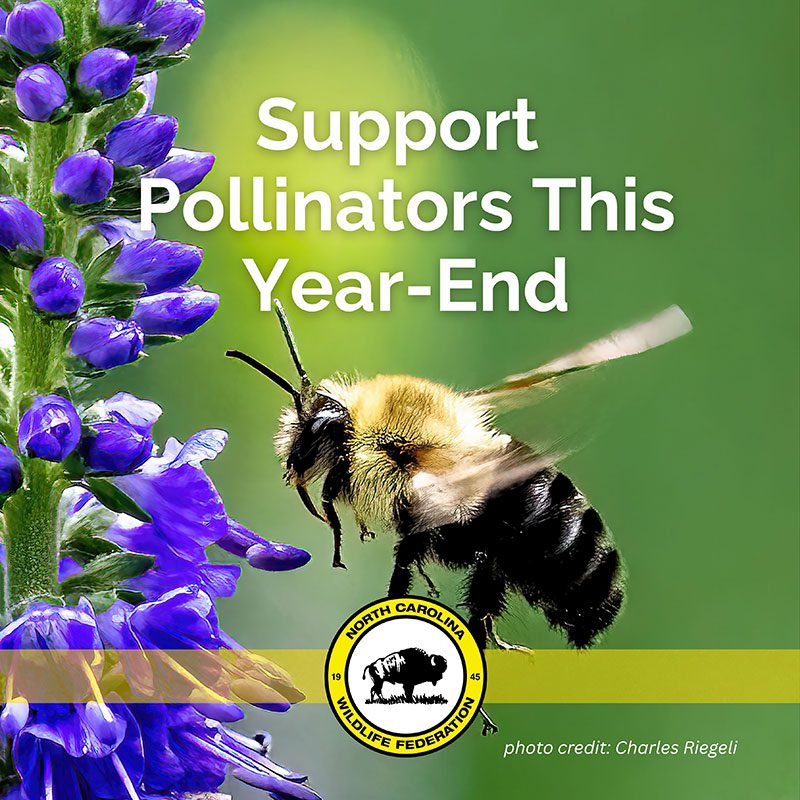Singing in Color – Eastern Painted Buntings in North Carolina

Flitting through the coastal forests and shrublands of North Carolina is one of the region’s most striking songbirds—the Eastern painted bunting. With feathers as vivid as a sunrise, the Eastern painted bunting (Passerina ciris) stands out brilliantly against the lush green backdrop of the southeastern United States. Often described as a “flying rainbow,” the adult male sports an unmistakable plumage of electric blue, lime green, and fiery red, making it one of the most colorful birds in North America. However, despite its dazzling appearance, this species faces serious threats and is a Species of Greatest Conservation Need (SGCN) in North Carolina.
Species Snapshot

Photo by Jeff Hall, NCWF Photo Contest Submission
Painted buntings are divided into two distinct populations—Western and Eastern. The Eastern painted bunting has a relatively limited range, extending from northern Florida through Georgia and South Carolina, and reaching into the coastal plain and southeastern corner of North Carolina (Florida Fish and Wildlife Conservation Commission). These birds prefer early to mid-successional habitats—ecosystems like shrubby fields, regenerating forests, maritime thickets, and coastal dunes. These dynamic habitats provide dense, shrubby vegetation for nesting and abundant insect life for feeding.
Males are flamboyantly colorful, while females and juveniles wear a more understated, yet beautiful, green plumage that helps them blend into the foliage. These small songbirds measure about five inches in length and typically weigh less than an ounce, but their song—a high-pitched, melodic warble—carries well across their habitat during the breeding season.
Why They’re a Species of Greatest Conservation Need
In North Carolina, the Eastern painted bunting’s highly specialized habitat needs make it especially vulnerable to urban development, land conversion, and habitat fragmentation. As a long-distance migratory species, any disruption to nesting, stopover, or wintering habitats can ripple across the entire population, compounding the risk at every stage of their journey.
One particularly alarming threat comes from illegal trapping. According to the U.S. Geological Survey (USGS), the capture of Eastern painted buntings and other songbirds in Florida remains an active issue resulting in population declines (USGS). The drafted North Carolina State Wildlife Action Plan (to be reviewed by the USFWS) further highlights that several species nesting in North Carolina—including the indigo bunting, painted bunting, and rose-breasted grosbeak—face risks on their wintering grounds due to poaching for the illegal pet trade and singing competitions: “Though the exchange of cage birds traditionally took place on the street, the advent of social media for advertising has led to a surge in the cage bird trade, particularly in the Caribbean” (NCWRC).
At the same time, the buntings’ preferred habitats—dense, shrubby vegetation in regenerating fields and maritime thickets—are vanishing. These dynamic spaces are increasingly replaced by monoculture lawns, sprawling coastal development, and fire suppression practices that prevent natural habitat renewal (NC Wildlife Resources Commission). Additionally noted by N.C. Wildlife Resources Commission (NCWRC) – as with many songbirds, Eastern painted buntings face threats from feral and free-ranging domestic cats. Outdoor cats, both feral and owned, are estimated to kill over a billion birds annually (Patronek 1998, Cornell Lab 2025).
Between 1966 and 2019, Eastern painted bunting populations declined by 33%, with pesticide exposure and continued coastal development among the suspected drivers (Smithsonian). These trends contributed to the species’ designation as a priority for conservation in the North Carolina State Wildlife Action Plan.
Adding to the urgency, North Carolina is currently the northern limit of the Eastern painted bunting’s breeding range—placing local populations at heightened risk from climate-related pressures, including shifting temperatures and rising sea levels.
Conservation in Action
To support the Eastern painted bunting and other vulnerable species, North Carolina Wildlife Federation (NCWF) facilitates a variety of community-based conservation initiatives—including the Butterfly Highway. This statewide habitat restoration program is designed to reconnect fragmented landscapes and bolster ecosystems for pollinators and other wildlife. While the project centers on pollinator health, it also benefits insectivorous birds like the Eastern painted bunting, which depend on robust native insect populations to feed their young during the breeding season.
The protection of coastal habitats by NCWF and partners further ensures that Eastern painted buntings remain present in the state. Such protective measures require the continued monitoring and restoration of Eastern painted bunting habitats.
In tandem, NCWRC has outlined priorities in the NC State Wildlife Action Plan, including statewide migration surveys to better understand how successional habitats and maritime forests are used by birds during critical life stages – including the Eastern painted bunting. For Eastern painted buntings specifically, continued long-term monitoring and banding efforts remain a key
recommendation. These activities contribute to the broader work of the USGS Painted Bunting Working Group, a multi-state collaboration focused on ensuring the species’ future.
Getting a Glimpse

Photo by Cathy Mencarini, NCWF Photo Contest Submission
Importantly, protecting the Eastern painted bunting is not solely a
coastal concern. While the majority of this species’ breeding activity in North Carolina occurs along the southeastern coast, occasional sightings have been documented farther inland—including in the Piedmont region at locations like Dorothea Dix Park in Raleigh. These inland appearances, though rare, underscore the importance of maintaining diverse habitat types throughout the state.
Birders hoping to spot Eastern painted buntings should focus their efforts along the state’s southeastern coastline during the breeding season, which runs from late April through August. Key areas include around Wilmington, Bald Head Island, and the barrier islands near the South Carolina border, where buntings favor early successional habitats such as shrubby fields, maritime thickets, and overgrown clearings.
To improve your chances at catching a glimpse of these beautiful birds, visit early in the morning, when birds are most active. Wildlife-rich destinations like Carolina Beach State Park, Fort Fisher State Recreation Area, and Brunswick Nature Park are known hotspots for this species. Painted buntings can be secretive, and frequently feed low in dense brush, so patience makes all the difference. Birding apps, local Audubon chapters, and platforms like eBird are valuable tools for tracking recent sightings and maximizing the chances of an encounter.
Looking Ahead
The irreplaceable presence of the Eastern painted bunting in North Carolina serves as both a celebration of biodiversity and a call to action. As habitat loss, climate change, and other threats continue to challenge this species, collaborative conservation efforts—ranging from coastal restoration to community science—are more important than ever. By protecting and restoring our state’s habitat these birds and other Species of Greatest Conservation Need depend on, we not only safeguard one of North America’s most colorful songbirds but also strengthen the health of our shared ecosystems for generations to come.
Written by:
– Olivia Yakabouski, NCWF Communications Intern

– Bates Whitaker, NCWF Communications & Marketing Manager



